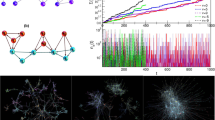Abstract
We continue the formal study of multiset-based self-assembly. The process of self-assembly of graphs, where iteratively new nodes are attached to a given graph, is guided by rules operating on nodes labelled by multisets. In this way, the multisets and rules model connection points (such as “sticky ends”) and complementarity/affinity between connection points, respectively. We identify three natural ways (individual, free, and collective) to attach (aggregate) new nodes to the graph, and study the generative power of the corresponding self-assembly systems. For example, it turns out that individual aggregation can be simulated by free or collective aggregation. However, we demonstrate that, for a fixed set of connection points, collective aggregation is rather restrictive. We also give a number of results that are independent of the way that aggregation is performed.


Similar content being viewed by others
Explore related subjects
Discover the latest articles, news and stories from top researchers in related subjects.References
Adleman LM (1994) Molecular computation of solutions to combinatiorial problems. Science 226:1021–1024
Adleman L, Cheng Q, Goel A, Huang MD (2001) Running time and program size complexity for self-assembled squares. In: Proceedings of the thirty-third ACM symposium on theory of computing. ACM Press, pp 740–748
Bernardini F, Gheorghe M (2004) Population P systems. J Univers Comput Sci 10(5):509–539
Bernardini F, Gheorghe M (2010) Tissue and population P systems. In: Păun et al. (2010), chapter 9, pp 227–250
Bernardini F, Gheorghe M, Krasnogor N, Giavitto JL (2005) On self-assembly in population P systems. In: Calude CS, Dinneen MJ, Păun Gh, Pérez-Jiménez MJ, Rozenberg G (eds) Uncoventional computation. 4th international conference, UC 2005, Sevilla, Spain, October 2005, Proceedings, vol 3365 of Lecture Notes in Computer Science. Springer, pp 46–57
Bernardini F, Brijder R, Rozenberg G, Zandron C (2007) Multiset-based self-assembly of graphs. Fundamenta Informaticae 75:49–75
Bollobás B (1998) Modern graph theory. Graduate texts in mathematics. Springer, Berlin
Desiraju GR (1989) crystal engineering: the design of organic solid. Elsevier, New York
Franco G, Jonoska N (2005a) Forbidding-enforcing conditions in DNA self-assembly. In: Chen J, Jonoska N, Rozenberg G (eds) Nanotechnology: Science and Computation, Natural Computing. Springer, Berlin, pp. 105–118
Franco G, Jonoska N (2005b) Forbidding-enforcing graphs for self-assembly. Congressus Numerantium 177:51–63
Gheorghe M, Păun Gh (2008) Computing by self-assembly: DNA molecules, polynominoes, cells. In: Krasnogor N, Gustafson S, Pelta D, Verdegay JL (eds) Systems self-assembly: multidisciplinary snapshots, studies in multidisciplinarity. Elsevier, Amsterdam, pp 49–78
Grantcharova V, Alm EJ, Baker D, Horwich AL (2001) Mechanisms of protein folding. Curr Opin Struct Biol 11(1):70–82
Jonoska N, Karl S, Saito M (1999) Three dimensional DNA structures in computing. Biosystems 52:143–153
Jonoska N, McColm GL (2005) A computational model for self-assembling flexible tiles. In: Calude CS, Dinneen MJ, Păun Gh, Pérez-Jiménez MJ, Rozenberg G (eds) Uncoventional computation. 4th international conference, UC 2005, Sevilla, Spain, October 2005, Proceedings, vol 3365 of Lecture Notes in Computer Science. Springer, pp 142–156
Jonoska N, McColm GL (2006) Flexible versus rigid tile assembly. In: Calude CS, Dinneen MJ, Păun Gh, Rozenberg G, Stepney S (eds) Uncoventional computation. 5th international conference, UC 2006, York, UK, September 4–8, 2006. Proceedings, vol 4135 of Lecture Notes in Computer Science. Springer, pp 139–151
Klavins E, Ghrist R, Lipsky D (2006) A grammatical approach to self-organizing robotic systems. IEEE Trans Automat Contr 51:949–962
Krasnogor N, Gustafson S (2005) A family of conceptual problems in the automated design of systems self-assembly. In: Proceedings of the second international conference on the foundations of nanoscience: self-assembled architectures and devices. pp 31–35
Li L, Garibaldi J, Krasnogor N (2006) Automated self-assembly programming paradigm: initial investigation. In: Proceedings of the third IEEE international workshop on engineering of autonomic and autonomous systems, 2006. EASe 2006. IEEE, pp 25–36
Neidle S (1999) Oxford handbook of nucleic acid structure. Oxford University Press, Oxford, UK
Păun Gh (2000) Computing with membranes. J Comput Syst Sci 61(1):108–143
Păun Gh (2002) Membrane computing. An introduction. Springer, Berlin
Păun Gh, Rozenberg G (2002) A guide to membrane computing. Theor Comput Sci 287(1):73–100
Păun Gh, Rozenberg G, Salomaa A (1998) DNA computing. New computing paradigm. Springer, Berlin
Păun Gh, Rozenberg G, Salomaa A (eds) (2010) Oxford handbook of membrane computing. Oxford University Press, Oxford, UK
Prime KL, Whitesides GM (1991) Self-assembled organic monolayers: model systems for studying adsorption of proteins at surfaces. Science 252:1164–1167
Rothermund PWK (2001) Theory and experiments in algorithmic self-assembly. PhD thesis, University of Southern California, Los Angeles, California, USA
Rothemund PWK, Winfree E (2000) The program-size complexity of self-assembled squares. In: Proceedings of the thirty-second ACM symposium on theory of computing. ACM Press, pp 459–468
Sa-Ardyen P, Jonoska N, Seeman N (2003) Self-assembling DNA graphs. Nat Comput 2(4):459–468
Saitou K (1999) Conformational switching in self-assembling mechanical systems. IEEE Trans Rob Autom 15(3): 510–520
Seeman NC (1998) DNA nanotechnology: novel DNA constructions. Annu Rev Biophys Biomol Struct 27:225–248
Soloveichik D, Winfree E (2007) Complexity of self-assembled shapes. SIAM J Comput 36(6):1544–1569
Whitesides GM, Boncheva M (2002) Beyond molecules: self-assembly of mesoscopic and macroscopic components. PNAS 99(8):4769–4774
Winfree E (1998) Algorithmic self-assembly of DNA. PhD thesis, California Institute of Technology, Pasadena, California, USA
Winfree E, Liu F, Wenzler LA, Seeman NC (1998) Design and self-assembly of two dimensional DNA crystals. Nature 394:539–544
Acknowledgments
F. Bernardini and R. Brijder were supported by NWO, the Netherlands Organisation for Scientific Research, project 635.100.006 “VIEWS”. G. Rozenberg acknowledges support by NSF grant 0622112. M. Cavaliere and G. Franco were supported by European Research Network SegraVis. We thank the reviewers for their valuable comments on the paper.
Author information
Authors and Affiliations
Corresponding author
Rights and permissions
About this article
Cite this article
Bernardini, F., Brijder, R., Cavaliere, M. et al. On aggregation in multiset-based self-assembly of graphs. Nat Comput 10, 17–38 (2011). https://doi.org/10.1007/s11047-010-9183-3
Published:
Issue Date:
DOI: https://doi.org/10.1007/s11047-010-9183-3



